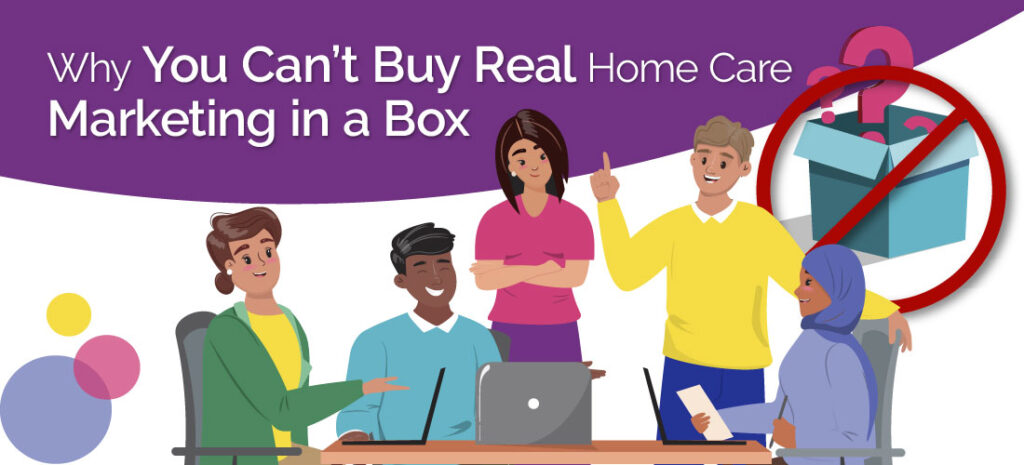
You can buy pre-packaged snacks, assemble-it-yourself furniture, and even subscription boxes for your dog. But building trust with families in crisis? That doesn’t come in a kit.
As automation and plug-and-play solutions seem to be taking over, it’s tempting to believe that marketing for a home care agency can be as easy as signing up for a pre-packaged service. Just pick a plan, choose some stock messaging, and wait for the leads to roll in. Right?
Not quite.
Home care is deeply personal, built on trust, relationships, and local reputation. The families looking for care aren’t just shopping for a product. They’re making emotional, life-changing decisions that require nuance, empathy, and a clear understanding of who you are and why they should trust you.
That’s why real home care marketing doesn’t come in a box. Here’s why the “one-size-fits-all” approach almost always falls flat—and what you should be doing instead.
Your Brand Is More Than a Logo and a Tagline
Many marketing companies offer “starter packages” that include a website template, a cookie-cutter tagline, and some stock social media content. While this might get something up and running quickly, it’s not the kind of foundation that builds long-term success.
Your home care brand is a reflection of your values, your culture, and your promise to the families you serve. It should reflect your “why,” which is what people connect with, especially when they’re facing vulnerable situations. A pre-written slogan doesn’t capture your story. And your story is your differentiator.
Every Community Is Different…And So Is Your Marketing
A home care agency in suburban Chicago faces different challenges than one in rural Texas or urban Miami. The competitors are different. Referral sources operate differently. Demographics, cultural values, and caregiver availability vary widely from region to region.
Boxed marketing services often fail to take your specific market dynamics into account. What works for an agency in one state may be completely ineffective in another. Effective home care marketing strategy requires research, local knowledge, and the ability to adjust tactics based on community needs and behavior.
Care Decisions Are Emotional. Your Marketing Should Be, Too.
Yes, SEO is important. Yes, Google Ads can drive traffic. But families aren’t just searching for “home care near me.” They’re asking deeper questions:
- Will this agency treat my mom with compassion?
- Will the caregivers be reliable?
- Can I trust these people in my home?
Answering these questions requires more than a keyword-optimized page. It demands messaging that resonates emotionally. It takes real stories, humanized content, and messaging specific to the kinds of concerns families express. That’s not something an off-the-shelf package can deliver.
Recruiting Caregivers Takes More Than a Job Post
Marketing for recruitment is not the same as marketing for client acquisition. And yet, many agencies try to use a one-size-fits-all approach here, too.
Caregivers are savvy. They’re comparing multiple job options, often juggling complex schedules, and looking for agencies that align with their values and offer a supportive culture. A templated job ad isn’t going to attract high-quality applicants. Real caregiver recruitment marketing involves everything from employer branding to ad testing to refining your applicant funnel. It takes trial, error, and insight.
Templates Get Stale. Real Marketing Evolves.
Templates and packages don’t adapt to industry changes, Google algorithm updates, or shifts in how people search for care. That means you might be using messaging or tactics that are outdated or ineffective.
Marketing needs to be dynamic. It’s not something you set and forget. It requires regular reviews of your website performance, ad spend, keyword rankings, and competitor activity. The best marketing is nimble, evolving with your agency’s growth and the needs of your audience.
You Offer Personalized Care—Your Marketing Should Match
If your whole brand promise is based on personalized, relationship-centered care, shouldn’t your marketing reflect that?
Pre-made templates and generic messaging say, “We’re just like everyone else.” Thoughtful branding and strategy say, “We care enough to speak directly to you.” Families and referral sources notice the difference.
Customized marketing communicates professionalism, authenticity, and credibility. It shows that you invest in how you show up, both online and offline.
Real Marketing Helps You Scale; Boxed Marketing Holds You Back
The goal of marketing isn’t just to “get more leads.” It’s to support your long-term business goals, whether that’s expanding into new territories, attracting private pay clients, or growing your reputation as a leader in your region.
Here’s what a real marketing strategy should include:
- Audience segmentation
- Data-driven ad targeting
- Content calendars based on seasonal needs
- Story-driven campaigns
- Referral relationship strategies
- Reputation management
None of that comes in a box. But it’s what helps you move from surviving to thriving in today’s home care market.
Don’t Settle for Generic
You wouldn’t deliver cookie-cutter care to your clients. So why settle for cookie-cutter marketing?
If you want your home care agency to grow with intention, grounded in your values and vision, invest in marketing that’s built for you. Because real home care marketing is never mass-produced. It’s handcrafted, like the care you provide.
Let’s talk about what real growth looks like for your agency. Schedule a free consult to explore a marketing strategy built around your voice, your mission, and your market.
